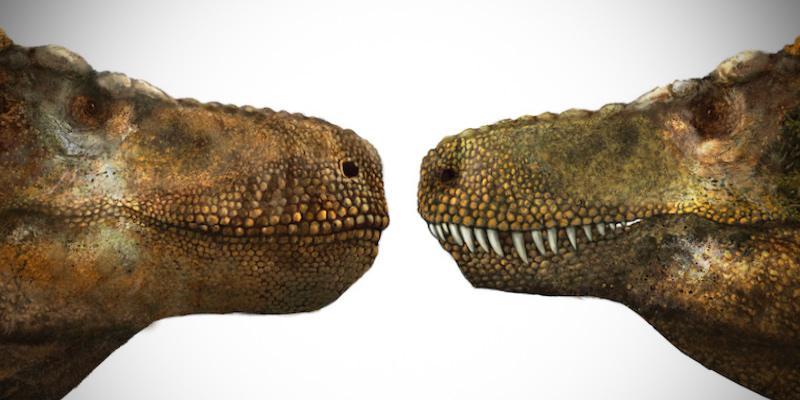(Graphic elaboration by Thomas M. Cullen et al., Science 2023)
Movies like “Jurassic Park” show them with their teeth always exposed, but according to a new study, they were covered by thin scaly lips
In Steven Spielberg’s film Jurassic Park, of 1993, on a rainy night on Tyrannosaurus rex (T-Rex) that wreaks havoc and destruction in the park manages to get out of its enclosure, eat a guy who had found refuge in a chemical toilet and approach with its huge jaws to Dr. Alan Grant. Before he decides to spare it, a close-up show effectively the sharp teeth of the T-Rex, so large that they always protrude from his mouth.
However, according to new research, it is likely that T-Rex and their closest relatives were a little different than we imagine them from the time of Jurassic Park especially for one detail: it seems that their teeth were hidden by scaly lips, similar to those of today’s lizards.
In the nineties Spielberg took quite a few licenses (first of all: despite the title many of the dinosaurs shown were not from the Jurassic), but perhaps that is precisely what makes the film special, to the point of still being considered the best of his type. In defense of him, the illustrations produced up to then of many dinosaurs contained various elements of fantasy, deriving mostly from the scarce knowledge on the characteristics of these large animals, which appeared about 230 million years ago.
Theropods, i.e. the group of dinosaurs which included, for example, T-Rex and velociraptors, were drawn in that way also due to observations on distant cousins of dinosaurs that still live on Earth today, such as crocodiles, and the only group of dinosaurs that still exists: birds. Both have stiff, immobile tissue around their jaws, unlike the scaly lips of lizards (iguanas, chameleons, geckos, monitor lizards, and so on). Consequently, it made sense to assume that theropods had stiff lips.
Around this hypothesis there had been a heated confrontation between paleontologists for some time and little data on which to compare. So it was that about ten years ago an international research group (United States, Canada, United Kingdom and China) decided to investigate the matter further. The many years of study have now led to the publication of a journal search Science which brings new elements on an age-old and non-secondary question for the study of animals that dominated the land for about 165 million years.
As they explain in their study, the researchers first of all studied the teeth of T-Rex, because in animals that have always exposed them there is greater wear on the teeth: this is the case for example of crocodiles. However, microscopic analysis of theropod fossils has not led to the observation of damage comparable to that observed among crocodiles today.
Theropod (A) and crocodile (F) teeth compared (Thomas M. Cullen et al., Science 2023)
The research team then compared some features of the jaws of lizards and crocodiles. Those of lipped lizards have a very small number of holes through which blood vessels and nerves pass to the gums, while those of crocodiles have a much higher number of these small openings.
How has explained Mark P. Witton, one of the researchers: “We noticed that theropod jaws resemble those of lizards more and have fewer openings near the jaw margins. The same is true of the ancient relatives of the now extinct crocodilians. This implies that the unusual facial anatomy of modern-day crocodilians evolved on its own, not as a trait shared with the dinosaur/bird group.”
(Thomas M. Cullen et al., Science 2023)
The research also took into consideration the size of the teeth, which for some dinosaur species were so large as to make it potentially difficult to have adequate lips to hide them. The research team calculated the ratio of tooth height to skull length in theropods, then compared it to that of Komodo monitors (Varanus komodoensis), the only lizards with lips to have feeding habits comparable to those of T-Rex and their relatives.
From the comparison it emerged that – given the necessary proportions – no carnivorous dinosaur had larger teeth than the monitor lizards. The same is not true for crocodiles, which have proportionally much larger teeth than theropods: “There is therefore no reason to think that dinosaur teeth were too large to be covered by lips,” explained Witton.
T-Rex skull (A), simulated lipless T-Rex with exposed dentition (B) and a lipped T-Rex (Thomas M. Cullen et al., Science 2023)
The data collected for the study was then used in some models to simulate how theropod jaws closed, leading to the conclusion that without lips, T-Rex and others could never have kept their mouths completely closed. Lack of adequate closure would have compromised their oral health and facilitated dehydration.
Based on all these elements, the study concludes that it was very likely that theropods had thin, scaly lips, but were unable to move them independently as mammals, for example, do. The new research has aroused great attention in the scientific community because it could offer important new insights not only for better understanding some characteristics of these long-extinct animals, but also the evolutionary processes that affected the animals we observe today.
